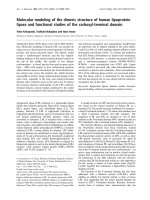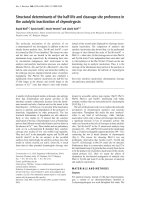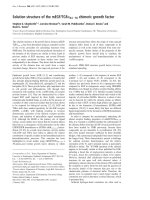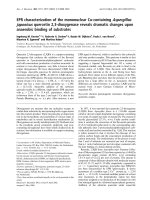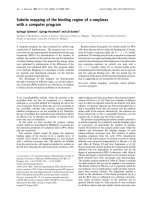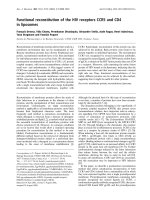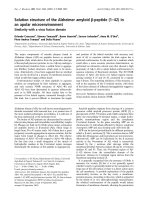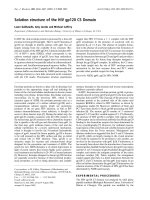Báo cáo y học: "Surgical reconstruction of the left main coronary artery with patch-angioplasty" pptx
Bạn đang xem bản rút gọn của tài liệu. Xem và tải ngay bản đầy đủ của tài liệu tại đây (566.58 KB, 5 trang )
RESEARC H ARTIC L E Open Access
Surgical reconstruction of the left main coronary
artery with patch-angioplasty
Ivo Martinovic
1*
, Hans Greve
2
Abstract
Background: Conventional coronary artery bypass grafting (CABG) has been established as the treatment of choice for
left main coronary artery (LMCA) stenosis However, the conventional grafting provides a retrograde perfusion to extensive
myocardial area and leads prospectively to competitive flow of the non-occluded coronaries thus consuming the grafts.
Surgical reconstruction of the LMCA with patch-angioplasty is an alternative method that eliminates these drawbacks.
Methods: Between February 1997 and July 2007, 37 patients with isolated LMCA stenosis were referred for surgical
ostial reconstruction. In 27 patients (73%) surgical angioplasties have been per formed. All patients were followed
up clinically and with transesophageal echocardiography (TEE) and coronary angiography when required.
Results: In 10 patients (27%) a LMCA stenosis could not be confirmed. There were no early mortality or
perioperative myocardial infarctions. The postoperative course was uneventful in all patients. In 25 pa tients, TEE
demonstrated a wide open main stem flow pattern one to six months after reconstruction of the left main
coronary artery with one patch mild aneurysmal dilated.
Conclusions: The surgical reconstruction with patch-angioplasty is a safe and effective method for the treatment
of proximal and middle LMCA stenosis. Almost one third of the study group had no really LMCA stenosis:
antegrade flow pattern remained sustained and the arterial grafts have been spared. In the cases of unclear or
suspected LMCA stenosis, cardio-CT can be performed to unmask catheter-induced coronary spasm as the
underlying reason for isolated LMCA stenosis.
Introduction
It has been estimated that isolated left main coronary
artery (LMCA) stenosis accounts about 1% of all cases of
coronary artery disease [1,2]. Isola ted ostial stenosis of
the LMCA is mostly caused by atherosclerotic plaques
[3]. Idiopathic fibromuscular hyperplasia and infla mma-
tory diseases such as post-radiation aortitis, syphilitic-
and Takayasu aortitis are rare causes of the LMCA steno-
sis [4,5]. Isolated LMCA stenosis are diagnosed usually by
coronary angiography, but this investigation itself can
cause main coronary artery spasms [6]. If these patients
are t reated by drugs, the 4- and 6-year survi vel rates are
65 and 44% respectively [7]. Despite of increasing cathe-
ter-based procedures with PTCA and stenting of the
LMCA, the results lead clearly to conclusion that the sur-
gical treatment, conventionally by coronary bypass
surgery remains the procedure of choice. Patch angio-
plasty was introduced in 1965 by Sabiston and colleagues,
as well as Effl er and colleagues [8,9 ], but was soon aban-
doned because of the high operative mortality. Hitchock
et al revived the concept 20 years later and suggested
that angioplasty is a valuable alternative to CABG with
excellent results [10]. Since then, only few small groups
have been enthusiastic reported with very good results.
However, patch angioplasty has not been accepted as a
standard method of treatment. Long-term results regard-
ing the patency rate and clinical outcome after the patch
LMCA angioplasty, contrary to CABG, are limited.
The aim of the present study was to review the mid to
long-term outcomes of LMCA ostial reconstruction with
saphenous vein patch at our center.
Patients and Methods
The study group consisted of 37 patients with isolated
LMCA stenosis referred for surgical ostial reconstruc-
tion, of 7200 patients who underwent surgical coronary
* Correspondence:
1
Department of Cardiothoracic Surgery, Philipps University Marburg,
Germany
Full list of author information is available at the end of the article
Martinovic and Greve Journal of Cardiothoracic Surgery 2011, 6:24
/>© 2011 Martinovic and Greve; licensee BioMed Central Ltd. This is an Open Access article distributed under the terms of the Creative
Commons Attri bution License ( which permits unrestricted use, distribution, and
reproduction in any medium, provided the original work is prope rly cited.
revascularization at our center between February 1 997
and July 2007. Age averaged 73 (46-87). 27 patients,
(73%), were male. All patients were followed up clini-
cally and with transesophageal echocardiography (TEE)
yearly. Because of unclear chest pain i n five patients,
without changes in the ECG and TEE and the ischemia
in one patient, six patients were followed up with coron-
ary angiography.
Preoperative findings
Preoperative angiography demonstrated significant ostial
LMCA stenosis in all patients.
Predominant aortic valve stenosis was present in 9
patients, predominant aortic valve incompetence in 2
patients. Diffuse, non significant coronary disease was
present in 6 patients. Myocardial bridge over the LAD
was present in one patient. Mild mitral valve incompe-
tence was diagno sed in 3 patients. Left ventricular ejec-
tion fraction (LVEF) was good in 15, moderate in 9 and
poor in 3 patients.
Operative Technique
Cardiopulmonary bypass, moderate hypothermia, cold
blood antegrade and retrograde cardioplegia with topical
cooling were used in all patients. The left ventricle wa s
vented by a catheter advanced through the right super-
ior pulmonary vein. We divided the pulmonary artery in
four cases in order to improve the exposure. An aortic
incision was used, beginning on the anterior medial wall
of the aorta. Both ostia were inspected and carefully
checked out with a 5 mm probe. In the patients with
confirmed LMCA stenosis, the left main stem was
reconstructed. The L MCA reconstruction technique has
been decribed before by Ridley [11]. After the aortic
cross clamping was completed, the main pulmonary
trunk was encircled with a silicone loop and retracted
laterally. The pericardial fat was removed from the
LMCA before incising the cor onary ostium. The aortic
incision was directed into the ostium of the LMCA and
extended through the LMCA to the bifurcation of the
circumflex and left anterior descending artery branches.
Ostial reconstruction was performed with a saphenous
vein in all patients. The vein patch was used to enlarge
notonlyLMCAbutalsotheareaoftheaorticincision
(Figure 1). A continuous 7-0 polypropylene was used to
create a new funnel-shaped LMCA segment and a con-
tinuous 5-0 polypropylene suture was used onto the
adjacent aortic wall.
Operative findings
In 10 patients, a LMCA stenosis could not be con-
firmed; the LMCA ostium was easily passed by the 5
mm probe. One of them had long stenosis with a mus-
cle bridge over the left anterior descending artery, which
was released by inc ision of myocardium. In other 9
patients, one venous graft to LAD was performed for
safety reasons. In 27 cases the ostium stenoses were
confirmed and enlarge d with saphe nous vein patch. In
two patients with massive calcification, an enda rterect-
omy had to be performed. In one of these patients, two
bypass grafts were performed in addition to the main
stem angioplasty. Figure 2 shows the coronary angiogra-
phy of the patient w ith intraoperatively confir med
LMCA stenosis. Narrowing of the left coronary ostium
by spasm is seen on F igure 3. In one female patient,
endarterectomy with patch enlargement was not
performed, because calcification included the bifurca-
tion, thus a conventional bypass revascularization wa s
performed.
The average aortic cross-clamp time was 34 &
(plusmn) 14 minutes (range 24-62 minutes, the CPB
time 54 &(plusmn) 16 minutes (range 43-87 minutes),
and the total duration of the operation 113 &(plusmn)
14 minutes (range 93-136 minutes).
Results
Early results
The operation was u neventfull in all but one patient,
who developed signs of ischemia in the ECG after dis-
connecting the extracorporal circ ulat ion. The branches
of the left coronary artery were grafted in addition and
IABP was started.
The postoperative course was uneventful in all cases.
There was no in-hospital death. No postoperative myo-
cardial infarction was observed. The mean stay in the
Figure 1 Patch-angioplasty with autologous saphenous vein.
Martinovic and Greve Journal of Cardiothoracic Surgery 2011, 6:24
/>Page 2 of 5
ICU was 11.2 hours and the mean hospital stay 6.4 days.
There were no significant clinical complications.
Follow-up
All patients underwent follow-up clinical examination
and transesophageal echocardiography (TOE) yearly.
TOE demonstrated a wide open LMCA physiological
flow pattern i n all pat ients with not confirmed LMCA
stenosis. The duration of follow-up ranged from 3 to
120 months (mean 59 &(plusmn) 34 months. Normal
flow pattern and none calcification of the patch were
demo nstrated in 25 patients. In 5 patients the angiogra-
physhowedalargemainstem1to6monthsafter
reconstruction of the coronary arteries. In one patient,
acute coronary syndrome occurred within 6 months.
The angiography showed a significant stenosis of the
distal main stem at the end of the patch enlargement
(Figure 4). A coronary artery bypass grafting procedure
had to be performed immediately.
Discussion
Coronary angiography is the standard procedure used to
identify definitive coronary anatomy. Other methods are
magnetic resonance imaging (MRI) [12] and Doppler-
echocardiography [13], preferably by transesophageal
approach [14]. The proximal parts of the main coronary
Figure 2 LMCA stenosis.
Figure 3 Spasm of the ostial LMCA Figure 4 Stenosis after patch angioplasty.
Martinovic and Greve Journal of Cardiothoracic Surgery 2011, 6:24
/>Page 3 of 5
artery can be visualized very well by intravascular ultra-
sound (IVUS), and by electron-beam CT scanning [15].
Invasive catheterization can lead to mechanically induced
spasm of coronary arteries. In the cases of unclear or sus-
pected LMCA stenosis, CT angiography can be per-
formed to unmask catheter-induced coronary spasm as
the underlying reason for isolated left main coronary
artery stenosis seen in invasive angiography. Coronary
vasospasm is defined as a decrease in the caliber of the
coronary arteries with evidence of ischemia , commonly
known as variant or Prinzm etal ’ s angina. This degree of
ischemia may be significant enough even in patients with
normal coronaries to produce myocardial damage as
indicated by elevated cardiac troponin I and cardiac
arres t [16,17]. Variant angina typically occurs during rest
or at nigh t. Cigarette smoking is the major risk factor for
coronary vasospasm [18]. Additional factors implicated
in vasospasm include hypocalcemia, [19], sotalol [20],
pseudoephedrine, [21], hyperventilation [22] and cocaine
use [23]. 10 of 37 patients in our cohort , reffer ed for sur-
gical reconstruction of the LMCA had no really stenosis.
The LMCA could have easily passed with a 5 mm probe.
8 of them had a concomitant aortic valvular disease. Dys-
pnea was a predominant symptom in these patients. A
heavy spasm must have been occurred during angiogra-
phy. For safety reasons one vein bypass was performed as
suggested by Soga et al [5]. In our opinion these patients
have benefited of the plan to perform the reconstruction .
Otherwise a competitive flow after CABG with patent
LMCA would have consumed the grafts in this cohort
very soon.
While single authors report good results of unpro-
tected left main coronary artery PTCA and stenting, the
results of the German PTCA Registe r show different
experiences; the mortality rate was more than 9% in
cases of angioplasty of unprotected LMCA stenosis and
even of 4,8% in angioplasty of LMCA stenosis with very
good collateralization.
These results lead to the conclusion that surgical treat-
ment is much superior to PTCA. Ostial stenoses are trea-
ted customarily by performing coronary bypasses to both
great branches of the left coronary artery. However, con-
ventional CABG method restores less physiological, ret-
rograde perfusion of the myocardium, may also lead to
occlusion of the LMCA, can result in competitive flow
and consumes bypass material. Surgical reconstruction of
the LMCA a voids these potential i nconvenien cies, and
additionally allows subsequent percutaneous coronary
intervention of the distal coronary tree.
Several different operative approaches have been
described [8,10,24-27]. In our study, we used only ante-
rior approach as first described by Sullivan and Murphy
[24]. We only used fresh autologous saphenous vein
patch for reconstruction because it is simple to be sewn
andiswideenoughtocreateafunnelshapedLMCA
ostium. Dion and colleagues suggested that the saphe-
nous vein patch owing its potential fibrinolytic activity,
might be preferable to autologous pericardium [28].
Theoretically, the autologous vein has a tendency to
proliferative degeneration resembling that of CABG
using the saphenous vein. Also, because of its elasticity,
autologous vein patches tend to dilatation [29]. In our
group one vein patch looked as moderate dilated and
was documented in the first patient with extensive calci-
fication in the bifurcation and endarterectomy of the
distal LMCA (Figure 5). We expected this finding cause
we produced it intentionally. In that patient we did not
inspect the whole length of the LMCA before incising
its ostium. We started incising a moderately calcified
proximal LMCA and than found excessive calcification
in the distal part and bifurcation. Extensive angioplasty
with large vein patch was essential. However, no pro-
gression of the patch “dilatation” in the follow-up has
been seen. In our series of patients there was only one
patient with restenosis in the follow-up. In this patient
with distal main stem stenosis, the endarterectomy was
performed b efore reconstruction. Thus, we suggest that
the presence of isolated stenosis only in the proximal
and middle part of LMCA a nd the absence of severe
calcifications should be considered as indications for
surgical reconstruction. In the cases of unclear or sus-
pected LMCA stenosis, our actual concept is to perform
Figure 5 Dilated vein patch after angioplasty.
Martinovic and Greve Journal of Cardiothoracic Surgery 2011, 6:24
/>Page 4 of 5
a cardio-CT in order to unmask catheter-induced cor-
onary spasm as the underlying reason for isolated
LMCA stenosis.
Conclusion
The surgical reconstruction with patch-angioplasty is a
safe and effective method for the treatment of the proxi-
mal and the middle LMCA stenosis. Endarterectomy
and reconstruction should be avoided in the case of dis-
tal left ostial stenosis and excessive calcification. Long
term follow-up is required to determine the patency in
order to eva luate this method. Left ostial stenosis could
not be confirmed in almost one third of the study
group: antegrade flow pattern remained sustained and
the arterial grafts have been spared.
Author details
1
Department of Cardiothoracic Surgery, Philipps University Marburg,
Germany.
2
Department of Cardiothoracic Surgery - Klinikum Krefeld -
Germany.
Authors’ contributions
IM carried out the study. HG participated in the design of the study. All
authors read and approved the final manuscript.
Competing interests
The authors declare that they have no competing interests.
Received: 15 June 2010 Accepted: 4 March 2011
Published: 4 March 2011
References
1. Loop FD, Lytle BW, Cosgrove DM, Sheldon WC, Irarrazaval M, Taylor PC,
Groves LK, Pichard AD: Atherosclerosis of the left main coronary artery: 5
year results of surgical treatment. Am J Cardiol 1979, 44:195-201.
2. Barner HB, Naunheim HS, Fiore AC, McBride LR, Pennington DG, Kaiser GC,
Willman VL: Coronary ostial stenosis. Eur J Cardiothorac Surg 1988,
2:106-112.
3. Thompson R: Isolated coronary ostial stenosis in women. J Am Coll
Cardiol 1986, 7:997-1003.
4. Briffa NP, Clarke S, Kugan G, Coulden R, Wallwork J, Nashef SA: Surgical
Angioplasty of the left main coronary artery: Follow up with magnetic
resonance imaging. Ann Thorac Surg 1996, 62:550-552.
5. Soga Y, Okabayashi H, Shimada I, Enomoto S, Matsubayashi K, Kamikawa Y,
Saitoh Y, Nagasawa A, Morimoto T: Plastic surgical reconstruction of the
left main coronary artery. Jpn J Thorac Cardiovasc Surg 1999, 47:95-98.
6. DeMots H, Bonchek LI, Roesch J, Anderson RP, Starrr A, Rahimtoola SH: Left
main coronary artery disease. Risk of angiography, importance of
coexesting disease ofother coronary arteries and effects of
revascularization. Am J Cardiol 1975, 36:136-141.
7. Jain D, Kurowski V, Reppel M, Katus HA, Rishardt G: Severe, resistant spasm
of the left main coronary artery. Aserious pitfall. J Invasive Cardiol 2000,
12:327-329.
8. Sabiston DC, Ebert PA, Friesinger GC, Ross RS, Sinclair-Smith B: Proximal
endarterectomy: arterial reconstruction for coronary occlusion at aortic
origin. Arch Surg 1965, 1:758-764.
9. Effler DB, Sones FM, Favaloro R, Groves LK: Coronary endarterectomy with
patch graft reconstruction: clinical experience with 34 cases. Ann Surg
1965, 162:590-601.
10. Hitchcock JF, Robies de Medina EO, Jamboroes G: Angioplasty of the left
main coronary artery for isolated left main coronary artery disease.
J Thorac Cardiovasc Surg 1983, 85:880-4.
11. Ridley PD, Wisheart JD: Coronary ostial reconstruction. Ann Thorac Surg
1996, 62:293-5.
12. Botnar RM, Stuber M, Kissinger KV, Manning WJ: Freebreathing 3D
coronary MRA: The impact of “isotropic"imageresolution. J Magn Reson
Imaging 2000, 11:389-393.
13. Jureidini SB, Marino CJ, Singh GK, Fiore A, Balfour IC: Main coronary artery
and coronary ostial stenosis in children: detection by transthoracic
colour flow and pulsed Doppler echocardiography. JAm Soc Echocardiogr
2000, 13:255-263.
14. Firstenberg MS, Greenberg NL, Lin SS, Garcia MJ, Alexander LA, Thomas JD:
Transesophageal echocardiography assessment of severe ostial left main
coronary stenosis. J Am Soc Echocardiogr 2000, 13
:696-698.
15. Bakhsheshi H, Mao S, Budoff MJ, Bin L, Brundage BH: Preview method for
electron beam CT scanning of the coronary arteries. Acad Radiol 2000,
7:620-626.
16. Wang CH, Kuo LT, Hung MJ, Cherng WJ: Coronary vasospasm as a
possible cause of elevated cardiac troponin I in patients with acute
coronary syndrome and insignificant coronary artery disease. Am Heart J
2002, 144:275-81.
17. Weston CF, Tigg A, Griffits BE: Pre-hospital cardiac arrest associated with
coronary artery vasospasm. Int J Cardiol 1993, 38:98-100.
18. Nobuyshi M, Abe M, Nosaka H: Statistical analysis of clinical risk factors
for coronary artery spasm: Identification of the most important
determinant. Am Heart J 1992, 124:32-8.
19. Magnus PC, Missri J: Hypocalcemia-associated coronary vasospasm. Conn
Med 2005, 69:3-7.
20. Muto S, Ashizawa N, Arakawa S: Sotalol-induced coronary spasm in a
patient with dilated cardiomyopathy associated with sustained
ventricular tachycardia. Intern Med 2004, 43:1051-1055.
21. Manini AFC, Kabrhel C, Thomsen TW: Acute myocardial infarction after
over-the-counter use of pseudoephedrine. Ann Emerg Med 2005,
45:213-216.
22. Fangio P, De Jonghe B, Lacherade JC: Coronary spasm in a 59-yr-old
woman with hyperventilation. Can J Anaesth 2004, 51:850-851.
23. Lange RA, Hillis LD: Cardiovascular complications of cocaine use. N Engl J
Med 2001, 345:351-358.
24. Sullivan JA, Murphy DA: Surgical repair for stenotic ostial lesions of the
left main coronary artery. J Thorac Cardiovasc Surg 1989, 98:33-36.
25. Eishi K, Sasaki H, Nakano K, Kosakai Y, Isobe F, Sasako Y, Kobayashi J:
Superior approach to the left main coronary artery for surgical
angioplasty. J Thorac Cardiovasc Surg 1997, 113:609-611.
26. Liska J, Jonsson A, Lockowandt U, Herzfeld I, Gelinder S, Franco-Cereceda A:
Arterial patch angioplasty for reconstruction of proximal coronary artery
stenosis. Ann Thorac Surg 1999, 68:2185-90.
27. Villemot JP, Godenir JP, Peiffert B, Zamorano J, Chocron S, Mattei MF,
Hubert T, Clavey M, Mathieu P: Endarterectomy of the left main coronary
artery stenosis by a transpulmonary artery approach. Eur J Cardiothorac
Surg 1988, 2:453-7.
28. Dion R, Verhelst R, Matta A, Rousseau M, Goenen M, Chalant C: Surgical
angioplasty of the left main coronary artery. J Thorac Cardiovasc Surg
1990, 99:241-250.
29. Jegaden O, Eker A, Durand de Gevigney G, Montagna P, Ossette J,
Mikaeloff P: Surgical angioplasty of the coronary trunks: an alternative to
bypass techniques. Coron Artery Dis 1994, 5:519-524.
doi:10.1186/1749-8090-6-24
Cite this article as: Martinovic and Greve: Surgical reconstruction of the
left main coronary artery with patch-angioplasty. Journal of
Cardiothoracic Surgery 2011 6:24.
Martinovic and Greve Journal of Cardiothoracic Surgery 2011, 6:24
/>Page 5 of 5
